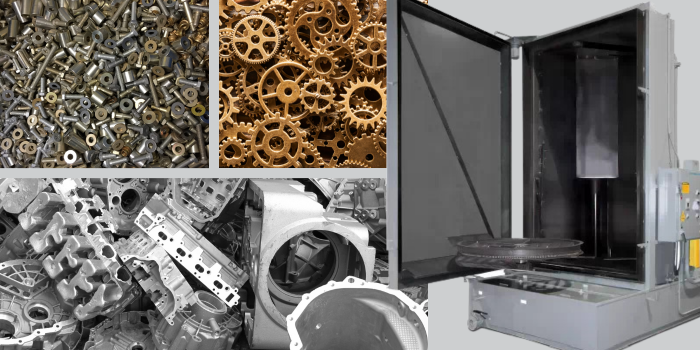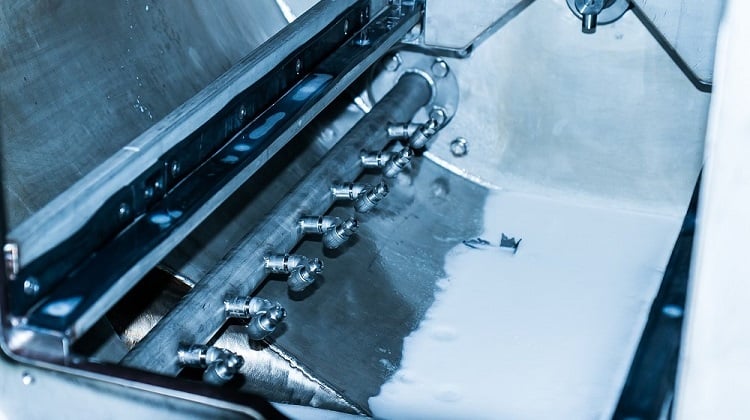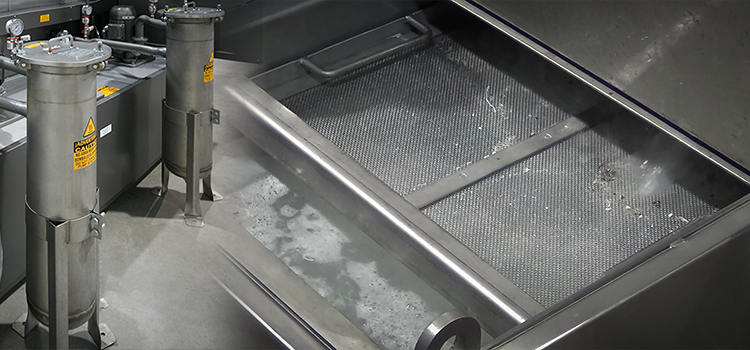COOLANTS IN MACHINING
In the world of metalworking for OEM components and assemblies, industrial parts washers are a critical piece of equipment to ensure parts meet the end-user’s performance requirements. Parts washing serves a different function from machining – to remove the oils and debris introduced by prior processes. A part’s surface may need to be cleaned for various reasons: it may directly affect the process immediately after (as in welding), or the end product may fail if contaminants remain in the system (as in transmissions). Interestingly, coolants are used almost universally in metalworking and parts washing. There is an irony in coolants being considered a contaminant, but that same contaminant also being used as a washing chemical. Alkaline cleaners present a compelling alternative, but when evaluating the efficacy of an alkaline cleaner, terms like ‘surfactant,’ ‘heat,’ ‘rust protection,’ and ‘approved chemicals’ are often mentioned. How do these terms factor into washing and surface preparation?
COOLANTS SELECTED AS CLEANERS
Coolants and alkaline cleaners have two properties that make them very similar: lubricity and detergency.
A coolant’s lubricity is defined by oil content. Oil can absorb heat faster than water as it passes over a hot object, making oil the critical component in effective cooling systems. Lubricity also correlates to the rust-preventative effect of a coolant, as it indicates how much oil coats the surface. Corrosion can have costly consequences, making rust prevention a key focus in manufacturing processes.
Coolants also require a degree of detergency. Detergency refers to the surfactant content of a fluid, which is what allows it to carry contaminants away as it passes over a surface. Engine oils have surfactants in them because oils have to both lubricate and flush away contaminants from the system for smooth operation. Fluids with high detergency prevent metallic chips and dust from building up on the cutting surfaces by using surfactants to carry away solid contaminants. Detergency is also why you will see coolants create foam as they are recirculated with a pump.
Ultimately, coolants have dominating lubricity properties that make them best suited for machining because they prevent heat generation, keep tooling clean, and provide rust protection. Unlike parts washing, machining is considered a value-added service, meaning the machining processes will dictate the critical chemicals of a plant for optimum cost efficiency. If coolants can serve the additional purpose of cleaning, it may be a compelling enough reason to use coolants in both metalworking and parts washing.
THE DOWNSIDE OF THE ONE-CHEMICAL-FITS-ALL APPROACH
Unfortunately, a chemical formulation cannot be qualified as a suitable cleaner simply by having lubricity and detergency properties. The relationship between the two properties is inversely proportional, meaning to gain lubricity, detergency is sacrificed and vice versa. The primary function of a coolant is dictated by its oil content, which means its dominant property is lubricity.
As the environmental temperature increases for the coolant (in machining, it is the metal surfaces; in cleaning, it would be the required tank temperature), the oil will separate to cool and lubricate. When using a coolant in a wash tank for cleaning, the tank needs to be heated up to between 40-60°C, which results in the oil in the coolant separating much like it would when the machining surfaces heat up. The problem with the oil separating is that it begins to be deposited on the parts rather than washing them, and it will spray onto the inner surfaces of the wash cabinet, setting up future parts for exposure to this separated oil.
After continuous duty cycles of washing with coolant, the blow-off cabinet of a parts washer will show a significant amount of orange or brown build-up on the interior surfaces. The initial symptom will be operator complaints about colored fluid on the parts after exiting the machine, requiring manual wiping. This will lead to the perception that the washer is no longer cleaning or drying the part. Over time, the same build-up will slowly block the air knives. Air knife blockage not only limits the removal of excess fluid but often overloads the motor.
Oil separation from coolant in the presence of heat can result in parts failing cleanliness requirements, whether those are visually free of solids or residues or particle count for a given surface area.
ALKALINE CLEANERS TO THE RESCUE
With the increased detergency, any oil content (albeit lower) in the chemical will remain stable as the environmental temperature increases and surfactants become the dominant agent. The surfactants will effectively remove both solid and liquid contaminants, resulting in a clean and dry part every time. At this point, it is perfectly valid to be concerned about an alkaline cleaner’s ability to protect against corrosion.
Returning to the idea of balancing lubricity and detergency, alkaline cleaners can be formulated with a rust preservative that lightly coats the part surface. As the part passes through the blow-off stage, the air knives can adequately remove excess fluid without the oil separating and depositing on the cabinet, and the surface will feel dry to the touch with a thin, clear film.
BARRIERS TO CHANGE
The argument for using purpose-formulated alkaline cleaners to wash metalworked parts is a favorable one; however, in manufacturing practices, a number of OEM and management-level approvals may be required to make chemical changes for a given process.
Introducing changes should only be driven by necessity. However, if parts are not meeting their cleanliness requirements, and all other factors have been ruled out, this should be considered an adequate impetus for change. An example would be an OEM cleanliness specification that may list approved cleaning chemicals (with rust-preventing additives) that are compatible with the operating fluids of the assembly in question. Chemistry change-overs must be on that list, and the manufacturer must consult with the OEM first.
In cases where cleanliness requirements have not evolved or there are minimum acceptance criteria, there may be no need to change the current cleaning chemical, even if it is a coolant.
GUIDANCE FOR SELECTION
When looking into optimizing an existing or future parts washer, the supplier will be able to provide guidance on suitability of the chosen wash chemical to meet the cleanliness requirements. Note that the parts washer supplier is typically different from the chemical supplier, and end users are encouraged to work with their trusted chemical supplier to select the correct chemistry for the process while referencing the OEM approval list. By understanding the key differences between the types of metalworking and cleaning fluids, users can make an informed decision on the proper cleaner.
FINAL THOUGHTS
Coolants have properties that make them versatile chemicals in a manufacturing environment, but they are not a one-size-fits-all answer. While they can flush away some particle contaminants, their primary purpose is to keep surfaces cool and lubricated; therefore, their efficacy in flushing away contaminants will decrease as the temperature of the environment increases. Understanding how coolants and alkaline cleaners work, puts the user in a position to determine the necessity of an alkaline cleaner. If the user is unsure, the parts washer supplier can provide guidance, while the chemical supplier can give specific recommendations. Chemistry is equally important as the machining process and specialists are available to answer any questions the user may have.


